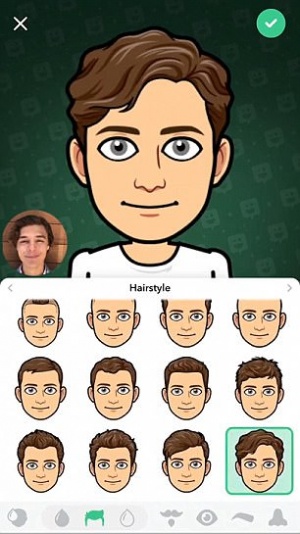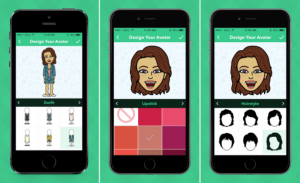Bitmoji
|
Contents
History
Bitmoji is a product of the Canadian company Bitstrips, which was founded in 2008 by Toronto-based Jacob Blackstock and Jesse Brown. Post college, Blackston worked in the cartoon and animation industry and was inspired by that experience to start Bitstrips[2]. Bitstrips was originally developed to create customized comic strips for those with less creative capabilities. In 2014, Bitstrips created a spinoff called Bitmoji which is one of their services that provides users an alternative way to communicate with others through personalized emojis. As a brand of the Bitstrips company, Bitmoji fits into almost all social media platforms’ communication methods. The concept of Bitmoji’s fills a communication void humans have been facing without even knowing it. Today, cell phones and social media are common ways to communicate with others, but Bitmoji brings back a variation of face to face interaction over messaging with human-like characters.
How It Works
Face Features
When creating a Bitmoji, users are prompted to first take a selfie of themselves that the application will use to compare their real face structure to a cartoon one. After this initial step, users have the opportunity to personalize their digital appearance with various attributes. Each quality is customizable to best represent an individual's unique looks. The main features available are hair color, eye shape, lip size, facial hair, and ear shape etc. In addition, the Bitmoji application also allows users to add or delete more specific characteristics such as jawline definition, cheek wrinkles, eyebrow color, and forehead lines. Having the power to change these features and portray a perfect image can impose its own implications.Body Features
Apart from the facial feature options Bitmoji gives users, the body features are also customizable. Users can choose to portray themselves as larger or smaller through their stomach and waist and can also alter breast and muscle size. This opportunity to choose physical features pressures users to fulfill social norms and expectations, which can lead to falsely representing themselves.
Outfit Choice
Choosing the bitmoji outfit allows users to convey their own personality through clothing style. The application offers a variety of outfits: jerseys with specific team names, classic hoodies, and jeans, some of which are offered through Bitmoji's own fictional lines such as the Bitmoji Collezione, Bitmo-Tees, and Basics X Bitmoji. There are also several seasonal lines Bitmoji has such as Bitmoji Harvest, Brrrmoji, and Bitmoji Sun, all of which are available during any season of the year for users who enjoy dressing their Bitmoji to the season they are dressing for.
Bitjmoji's clothing allows the user to represent their occupations as well. For examples, Bitmoji's can be dressed in a doctor's coat or a firefighter's helmet and jacket. Additionally, for women, Bitjmoji offers maternity clothing that can represent a pregnant user. Users can portray themselves how they want to regardless of their style in reality. The plethora of options gives users the ability to customize their physical appearance to their liking and the opportunity to be something they're not in real life.
Brands
Bitmoji has partnered with several brands to offer its users branded clothing options. There are sports-related clothing options such as Nike and Adidas as well as NHL, NFL, and NBA gear that allow users to show their support for their favorite teams. Brands such as Forever21 and Steve Madden have also partnered with Bitmoji, and avatars can be dressed similarly to their users who shop at these stores. Bitmoji has also advertised movie releases such as Ghostbusters and Batman V Superman by giving options to dress up like the main characters from the movies.
What Bitmoji is Used For
On Snapchat, Bitmojis are primarily presented as stickers through the Bitmoji keyboard used during chats or added on top of snapped pictures. Bitmojis are also seen "live" when used through a filter on snap. Bitmojis can be seen doing regular activities such as playing sports or cooking meals and can even be seen interacting with other Bitmojis if the user is replying directly back to a friend.
Where Bitmoji is Used
Bitmojis are versatile in the way they can be used in many different messaging applications and websites. With compatibility functions to incorporate the Bitmoji software in IOS and Android processes, Bitmoji can be used on any application within those realms. For example, users can send their personalized Bitmoji via iMessage, Snapchat, and Google Chrome along with other messaging platforms. Through IOS, Bitmoji is enabled on a user’s phone by simply adding the Bitmoji keyboard in the settings options. Google play, for Android users, also accepts the Bitmoji keyboard through its Google Keyboard. Apart from the mobile application usage, Bitmojis can also be used on desktops. Google Chrome is a large proponent of Bitmojis and allows users to use them while communicating through platforms such as Google Mail and Google Messenger on a desktop[3]. The seamless transition from using Bitmojis from mobile devices and tablets to desktops makes the service versatile in the methods is can be used to communicate with others around the world.
Ethical Concerns
Self-Representation
There is no page on the Bitmoji application that addresses the concern of misrepresentation of a user’s digital identity. A Bitmoji can represent someone in any way they like without being a true representation of who that person is physically. By altering face structure, body shape, clothing style, users can use this platform the create a real character that they want others to identify themselves with. Richard Mason described the four issues of information technology and one was accuracy[4]. The accuracy of a Bitmoji character depends on the person who is creating it but also on the intentions used when adding different features to the personalized emoji. Bitmojis can be seen as a non-normative identity where users represent themselves in ways that might not be socially acceptable. However, this type of identity can also be represented by the way someone chooses to represent themselves to the world. When sifting through the different features, as mentioned above, a user has the opportunity to look younger, prettier, skinnier, and more athletic etc. Naturally, most people want to represent themselves in the best way possible and show that to those whom they communicate with. The concept of ethical acculturation explains that a user’s actual self is in sync with their online identity[5]. When using a Bitmoji, ethical acculturation is impaired when there is a lack of balance between the true physical identity and the digital one. Smith and Watson explain that “ All self-presentation is performative - it’s manufactured.”[6]. This explains that how we present ourselves is tailored to our needs and can be formulated in in a synthetic manner.
Aspirational Bitmoji
How people create a Bitmoji by carefully chosen features represents how someone wants to be perceived by others. In most cases, to choose a Detroit Lions jersey as the outfit for a Bitmoji, that would indicate that you are a fan of that team. It could also mean that you want whoever you are sending the Bitmoji too, to believe that you are a Detroit Lions’ fan. Bitmoji even allows users to dress their character in a professional attire such as a firefighter suit or a chef to demonstrate one’s career interests[7]. Users can aspire to look like someone based on the features they select to use on their character. This aspiration can be a fake representation of what someone really wants to be just to please those who are viewing their cartoon avatar.
Constant Changes
Once a user creates a Bitmoji, they can go back as many times as they want to change different parts of its appearance. This can be deceiving to those who receive the Bitmoji because the appearance of one’s digital identity is changing to fit the model society has deemed ‘normal’ for people to look like. Whether it is having long or short hair, blue eyes or brown eyes, or a slimmer body, people can change how they want others to see them through this application. The ethics behind doing this derives from the misrepresentation of one’s self to please society. An avatar, as Sam and Watson explain, “facilitate identity tourism”. An embodied identity is not altered with someone’s avatar but the way someone uses it to represent themselves can impose ethical implications[8].
Privacy Concerns
Upon downloading Bitmoji, users are asked to grant the application "Full Keyboard Access" in order to use the application. While the company claims that this is necessary in order to render personal Bitmoji images on a user's device, user's have raised concerns about the application storing data about what they are typing. [9] While the company claims they are not using keyboard access to gain and retain this information, it is not outside of their technical ability to do so. The application does not record keystroke information, but they do collect usage related data such as what types of stickers a user tends to send and from what kind of device they are sending from [9] Although these are all technically agreed on by the user upon downloading, there is an ethical concern that data obtained about a user could be leaked or used without their explicit permission. Furthermore, when the user grants "Full Keyboard Access," the application does not provide more information about what that entails.
Permissions
Bitmoji provides a list of permissions the user has consented to upon downloading the application. This includes but is not limited to[10]:
- In-app purchases: Bitmoji can ask users to make purchases inside the app
- Device and app history: Bitmoji can retrieve running apps
- Identity: Bitmoji can find accounts on the users’ device and read the users’ own contact card
- Contacts: Bitmoji can find accounts on the device, read the users’ contacts, and modify users’ contacts
- Phone: Bitmoji can read phone status and identity
- Photos/Media/Files and Storage: Bitmoji can read the contents of the users’ USB storage and modify or delete the contents of the users’ USB storage
- Camera: Bitmoji can take pictures and videos
- Microphone: Bitmoji can record audio
- Wi-Fi connection information: BItmoji can view Wi-Fi connects
- Device ID and call information: Bitmoji can read phone status and identity
- Other: Bitmoji can receive data from the internet, view network connections, full network access, run at startup, draw over other apps, and prevent device from sleeping
Bitmoji states that they have the ability to automatically add additional capabilities within each permission group without notifying the user.
References
- ↑ Vomiero, Jessica. “With Bitstrips Acquisition Confirmed, Snapchat Has Dropped Bitmojis Into Your Snaps”, (July ,2016),, https://betakit.com/with-bitstrips-acquisition-confirmed-snapchat-has-dropped-bitmojis-into-your-snaps/.
- ↑ Kruegar, Allison. “The Inside Story of Bitmojis: Why We Love Them, How They Make Money, Why They Are Here To Stay”(Mar.,2016)., https://www.forbes.com/sites/alysonkrueger/2016/03/24/the-deeper-meaning-behind-bitmojis-why-we-all-love-them-so-much/#556fef9f4a43.
- ↑ https://www.bitmoji.com.
- ↑ Mason, Richard. “Four Issues of the Information Age” MIS Quarterly Vol. 10, No. 1 (Mar.,1986), pp. 5-12., https://www.gdrc.org/info-design/4-ethics.html.
- ↑ Bash, Anderson. “An acculturation model for ethics training: The ethics autobiography and beyond.” (2007).,http://dx.doi.org/10.1037/0735-7028.38.1.60.
- ↑ Smith, Sidonie., Watson, Julia . “Virtually Me: A Toolbox about Online Self-Presentation”, (2014), chapter 6, https://quod.lib.umich.edu/m/maize/mpub9739969/1:12/--life-writing-in-the-long-run-a-smith-watson-autobiography?rgn=div1;view=fulltext.
- ↑ Silbert, Sarah. “What Exactly is Bitmoji?”, https://www.lifewire.com/bitmoji-explained-4137793.
- ↑ Smith, Sidonie., Watson, Julia. “Virtually Me: A Toolbox about Online Self-Presentation”, (2014), In Identity Technologies: Constructing the Self Online(pp. 70-96). University of Wisconsin Press.,https://quod.lib.umich.edu/m/maize/mpub9739969/1:12/--life-writing-in-the-long-run-a-smith-watson-autobiography?rgn=div1;v3ew=fulltext.
- ↑ 9.0 9.1 "Privacy risks of virtual keyboards: is Bitmoji safe?", (2018). https://nordvpn.com/blog/bitmoji-keyboard-app-privacy/
- ↑ https://play.google.com/store/apps/details?id=com.bitstrips.imoji


